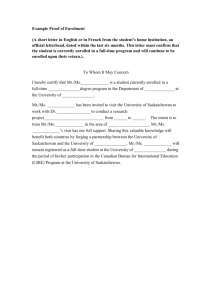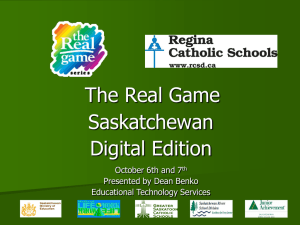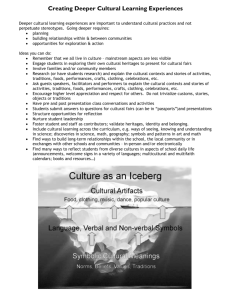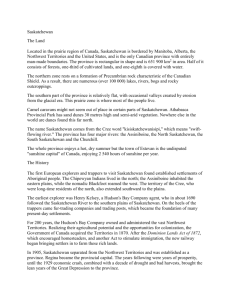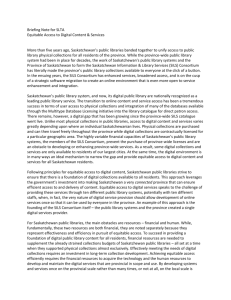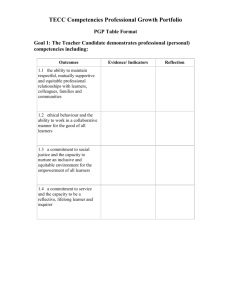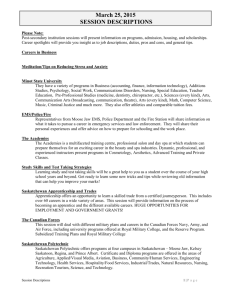Learning about Saskatchewan - K-5resourcepage
advertisement
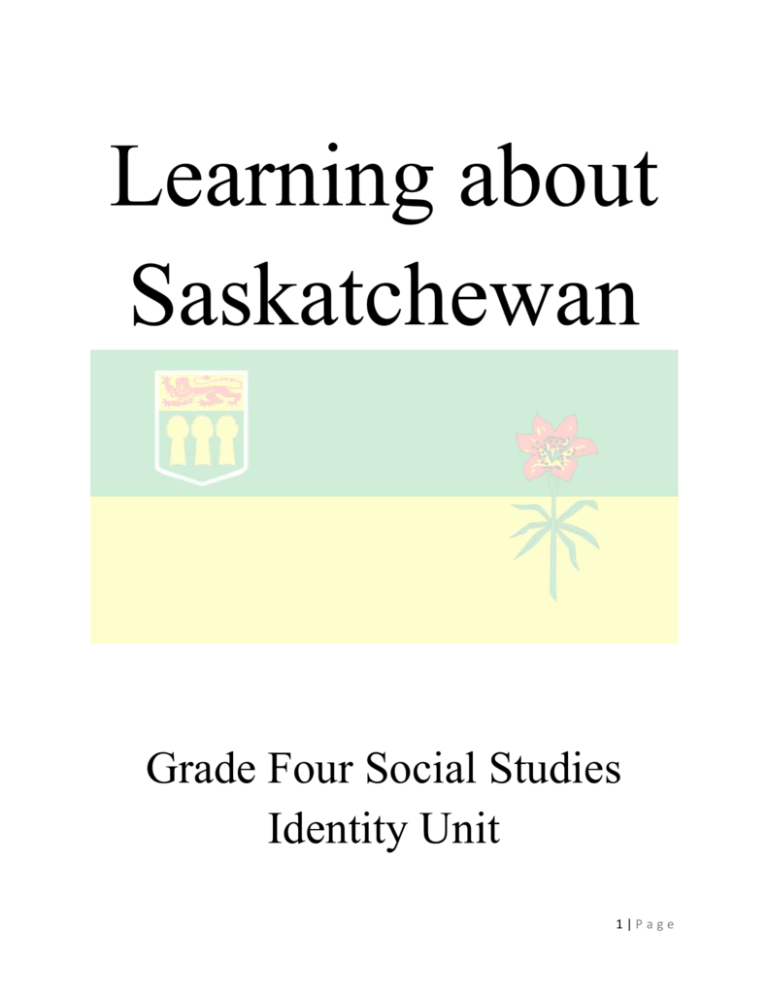
Learning about Saskatchewan Grade Four Social Studies Identity Unit 1|Page Scope This hierarchy explains the lessons that I will be focusing on and the content that will be taught within each lesson. The general theme between all the disciplines is Identity and students will be able to explore this theme through various experiential learning experiences that include simulation activities, webquest, planting seeds, three-dimensional gridding, a community story book, and a digital game (Jeopardy). Rational Saskatchewan is a unique area with regions and ecozones that are so vastly different. Not only are the ecozones different from one another, but also the weather and vegetation. It is important for students to understand how each one of these factors contributes to population distribution, employment opportunities and recreational activities. Students also need to be prepared to understand the symbols of Saskatchewan road maps as well as mapping, gridding, distance and direction are all major factors when travelling. Understanding these elements will help students with learning the identity of Saskatchewan. Major Concepts and Learning Objectives Concepts Identity province, geographic features, map, scale, direction, grid, climate, symbols, heroes Knowledge Objectives Students will know that: Saskatchewan, a province in Canada, has regions that may be defined by landforms, climate, and vegetation. various symbols have been identified to represent the province and its regions. various kinds of communities exist in northern/southern, rural/urban areas of the province. population distribution is related to various factors including opportunities for work. many Saskatchewan women, men, and children from many areas of work and recreation may be recognized as heroes. 2|Page Skills/Abilities Objectives Students will: interpret and create maps of local communities and the province. learn to see relationships between/among climate, landforms, vegetation, population distribution, and opportunities for work. identify provincial and regional symbols and describe their significance. Attitudes/Values Objectives Students will: appreciate and value the province's diversity. appreciate and value the province as a desirable place to live and work. value the achievements and contributions of people in their own community and province. Citizen Action Objectives Students may: work cooperatively in group tasks. practice seeing things from various points of view. identify and apply criteria to name heroes. Common Essential Learnings Independent Learning: Interpreting maps, directions, and Saskatchewan symbols. Personal and Social Values and Skills: Group work, resource sharing, class discussion Critical and Creative Thinking: Discussion of “Circle of Life” and ceiling gridding activity. Communication: Using vocabulary associated with this study. Numeracy: Temperature ( degrees C ) and measurements ( kilometres) Technological Literacy: Letter writing, webquest, digital game. 3|Page Adaptive Dimension While creating my unit, I consider the students who would benefit from alternations made in each lesson to help make them successful. I worked tedious long hours to think of ways that each one of my students can feel success at the end of each lesson. Some ways that I have adapted my lesson is to write plenty of notes or drawing on the board. Writing notes on the board will help those students who are visual learners because all they can do is look up to be reinforced of the context of the class. In addition, it also allows students to feel dependent because they do not need to rely on their classmates to ask questions because they can just look at the board. I have also incorporated group work into my lessons. Group collaboration is a beneficial way to have the stronger students and the weaker students come together to learn from each other. Group collaboration is good for learners who learn within a small group. It is lessintimidating for the student to ask questions amongst the entire class. There is no final exam, but instead there is a digital game, Jeopardy, which I will not be marking the same as a test, but this is a more relaxing way for students to be tested. Assessment & Evaluation – overall unit Growth Portfolio I have decided to use a Growth Portfolio for student learning. This is not really a form of assessment on the teacher’s behalf, but more so on the students behalf because they will be able to see how much they have grown over the course of the unit. I will use the reflections in the portfolio to determine if the student is making in-depth reflections. A small portion of the reflections will be marked. The students will be making reflections based on learning targets. The majority of the assessment will be done by the students, their classmates about each other and by myself. The assessment are student friendly, checklists and rubrics. The students will have a copy of the assessments and will be able to understand the expectations. Aboriginal Content and Perspective I have incorporate Aboriginal content of the past and content of the future. I think it is important for students to understand aboriginal history, but also learn that aboriginal culture has changed over time just like the identity of Saskatchewan. 4|Page In the first lesson, students will read an article about Aboriginal purpose for the Western Red Lily, although now it is wrong to pick the flower the culture needs to seek a new source. In lesson four, students reflect on Aboriginal culture by using the “Circle of Life” activity. Technology A webquest is used which allows students to access internet addresses to obtain information. There is also a digital game, Jeopardy, that the students will play come the last stages of the unit. This game is a fun and interactive way for students to review the unit content instead of writing a pencil and paper exam. Classroom Management For my classroom management I use a music triangle. I find this method to be very successful because it makes a soft noise that all students can hear clearly. What I do is I hit the triangle three times and each hit represents an action. The first hit represents “Stop”, the second hit represents “Look” and the third hit represents “Listen”. At times, I will even whisper into a student’s ear offering them to hit the triangle three times and they become really excited as well as their classmates too. I like this method because it avoids me to raise my voice and I find that when I raise my voice, the reaction of the students is much different compared to when I use the triangle. I use this method in the majority of my lessons, with the exception of physical education. Materials and Resources Equipment/Materials: Lesson One: - Compass Rose Sheets Saskatchewan Flag Sheets Saskatchewan Sheet Saskatchewan Official Symbols and Emblems Sheet Western Red Lily Story and Questions. Lesson Two: - Student Information Sheet Big Sask. Map- Climate sheet, “SK Shopping List” sheet “Employment Opportunities” sheet 5|Page - Color markers Computer Lab Pre-made groups Head phones Lesson Three: - Student Information Sheet Big Sask. Map- Climate sheet, “SK Shopping List” sheet “Employment Opportunities” sheet Saskatchewan map Furs and pictures Lesson Four: - Working with grid and coordinates sheet Working with grid and symbols Lesson Five: - Working with grid, direction and distance sheet. Post-it String Scissors Lesson Six: - “What is a hero” sheet Graphic Organizer Lesson Seven: - Hero Class Book Piece of paper Hole puncher 6|Page Lesson Eight: - Jeopardy game Internet Resources: Lesson One: - - - Saskatchewan Official Symbols and Emblems page: http://www3.sympatico.ca/goweezer/canada/embSASK.htm Western Red Lily Story page: http://www.usask.ca/education/coursework/mcvittiej/resources/redlily/elementary/pdffile s/story.pdf// Write some things that you already know about Saskatchewan page: http://www.usask.ca/education/coursework/mcvittiej/resources/redlily/elementary/pdffile s/story.pdf// Blank Saskatchewan Map: http://edimage.ca/edimage/ludique/coloriage/drapeaux/cg_sask.gif// Compass Rose Sheet: http://www.enchantedlearning.com/geography/printouts/compassrose.shtml// Lesson Two: - - Webquest address (references are listed on each page): http://learningaboutsk.wikispaces.com/ Rubric used for students to use and for teacher to use: http://www.saskschools.ca/curr_content/science9/saskenviro/worddocs/lesson3/rubric1.p df// Saskatchewan Map: http://www.canadainfolink.ca/Saskplcs.jpg// Lesson Three: - http://www.literacycommunity.com/grade3/firstnations/environment.htm Books: - Fiddle Dancer by Anne Patton & Wilfred Burton. Illustrator Sherry Farrell Racette A Prairie Alphabet by Jo Bannatyne-Cugnet & illustrator Yvette Moore Nathaniel’s Violin by Alison Lohans & illustrator Marlene Watson A Prairie Year by Jo Bannatyne-Cugnet Sundog Rescue by Alison Lohans & illustrator Vladyana Langer Krykorka Waiting for the Sun by Alison Lohans with illustrators Marilyn Mets & Peter Ledwon Heartland: A Prairie Sampler by Jo Bannatyne-Cugnet & illustrator Yvette Moore From Far and Wide: A Canadian Citizenship Scrapbook by Jo Bannatyne-Cugnet & illustrator Song Nah Zhang 7|Page - The Canadian Shield Alphabet by Myrna Guymer & illustrator RoseMarie Condon Hidden Buffalo by Rudy Wiebe & illustrations by Michael Lonechild Qu’Appelle by Dave Bouchard & illustrations by Michael Lonechild The Pow-wow by Darrell Pelletier Tunnels of Time by Mary Harelkin Bishop Pelly by Dave Glaze Christmas at Wapos Bay by Jordan Wheele 8|Page
